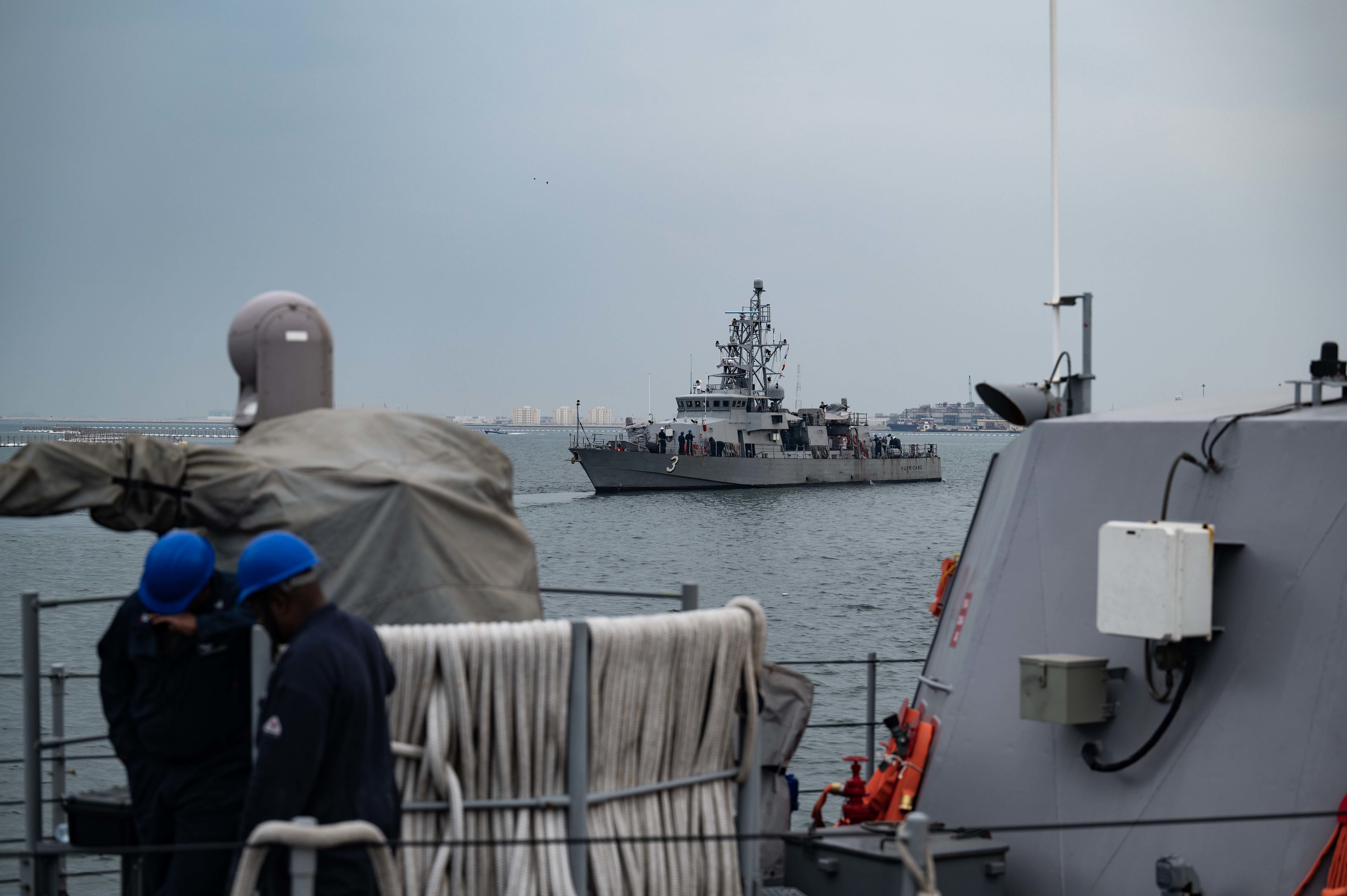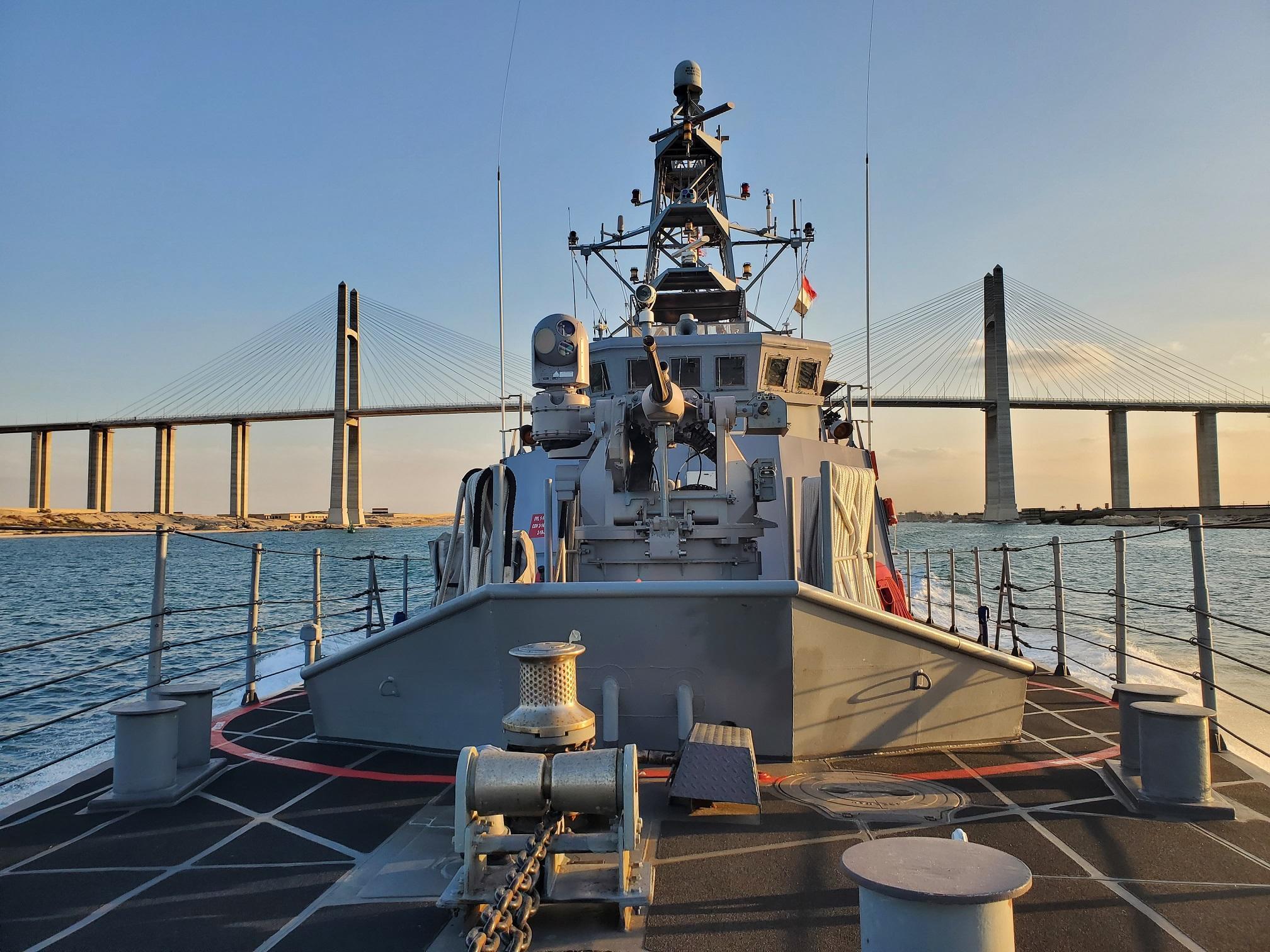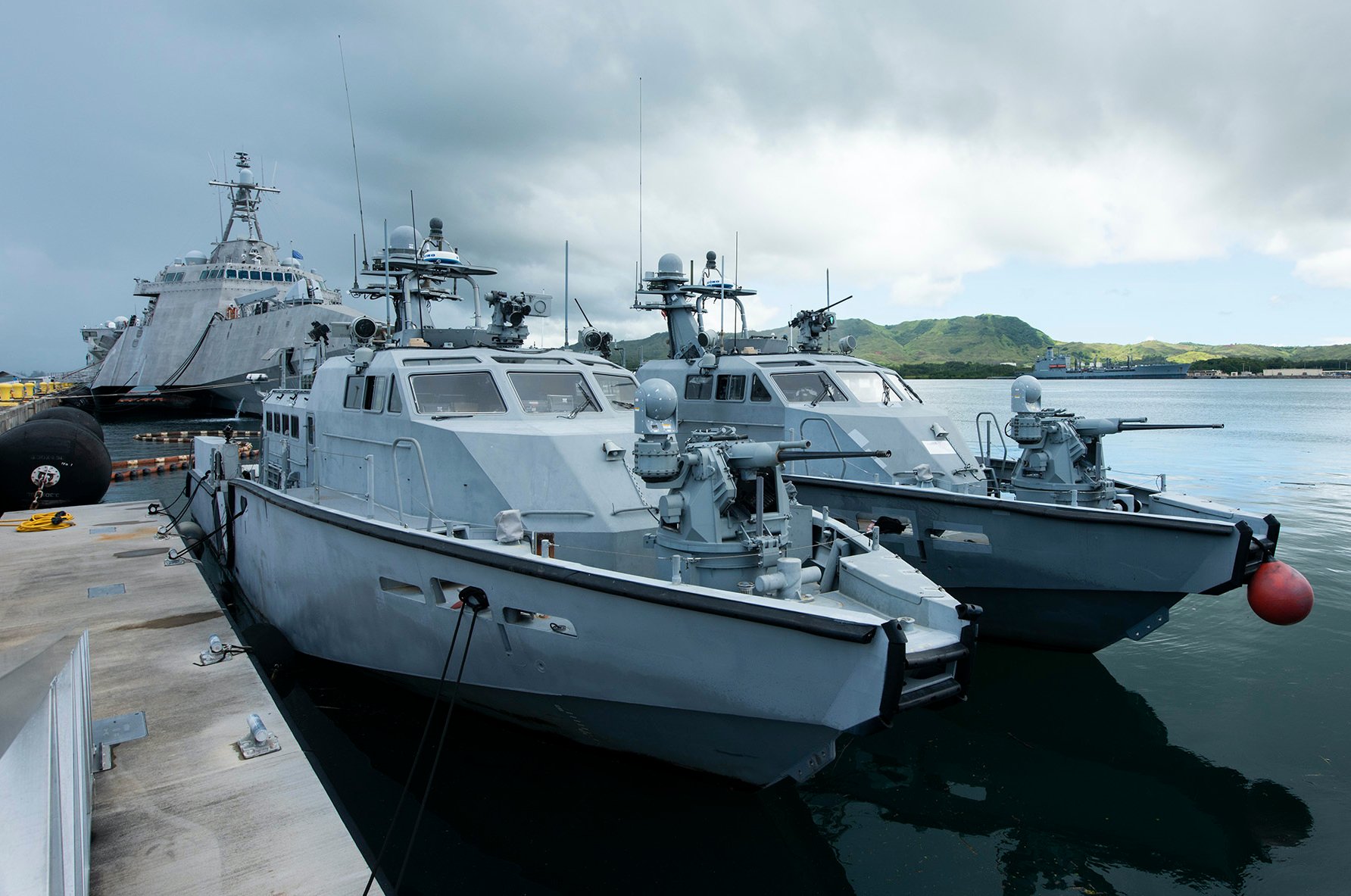Cyclone-class coastal patrol ships assigned to Patrol Coastal Squadron 1 (PCRON 1) sail in formation during a divisional tactics exercise in 2014. US Navy Photo
The U.S. Navy decommissioned the last two Cyclone-class patrol ship at Naval Support Activity Bahrain last month, bringing the almost three-decade-long service of the PCs to an end. The Cyclones that have patrolled in and out of the Persian Gulf are set for foreign service. Over the last two years, the remaining PCs have been transferred via Foreign Military Sales to Bahrain, Egypt and the Philippines.
Built by Bollinger Shipyards, the 385-ton Cyclones have been a staple in littoral environments. Designed for patrol duties and interdiction, the vessels would serve in both the Navy and Coast Guard over the class’ service life, mostly in the Middle East, where the Navy preferred them over larger vessels for operations in the Persian Gulf. Since 2014, ten of the fourteen PCs of the class were stationed at Naval Support Activity Bahrain.
Philippine Navy’s Littoral Combat Force

USS Monsoon (PC-4) and USS Chinook (PC-9) transferred Philippine Navy in a ceremony in Bahrain on April 15, 2023. AFP Photo
In attendance for the decommissioning of the last PCs – USS Monsoon (PC-4) and USS Chinook (PC-9) – were their future operators. Monsoon and Chinook were officially transferred to the Philippine Navy during the same ceremony in which they were decommissioned at the pier in Bahrain. The Philippine delegation included the Commander of the Philippine Fleet Rear Adm. Renato David.
Philippine media outlet Inquirer received word from a senior Philippine Navy official that the PCs were due to arrive in May of this year. They are to spend 60 days in refit to adapt the vessels for Philippine service. Monsoon and Chinook will be the first PCs to enter the Philippine Navy since 2004, after the former USS Cyclone’s (PC-1) transfer to the Philippines via FMS.
For almost two decades the Littoral Combat Force, the command within the Philippine Navy responsible for patrolling the internal and littoral waters of the country, operated a single PC. BRP General Mariano Alvarez (PS-38), former USS Cyclone (PC-1), has distinguished itself in the Philippine Navy over the years in counter-insurgency and maritime security operations in the Southern Philippines, where the country faces various rebel groups.
General Mariano Alvarez was envisioned to be the first of many PC transfers to the Philippines. But with the Global War on Terror kicking off, the U.S. Navy retained the vessels for their own use.
Apart from these operations, the Philippines also wanted the PCs to modernize the LCF, with many of its vessels dated or nearing retirement. The Philippine Navy prioritized the transfer of PCs to the point that the service would rather take multiple PCs over a potential Hamilton-class WHEC transfer. The Philippine Navy sent exploratory teams over the years to PC homeports in Bahrain and Mayport, Fla., to evaluate which vessels could be transferred. Originally, the Philippine Navy wanted five PCs, but also said that if it came down to it they “will only get the best available units,” officials said.
In all, the Philippine Navy has received three of the 14 total PCs built. The Philippine service names for Monsoon and Chinook are unknown as of this time.
Royal Bahraini Naval Force

Patrol coastal ship USS Hurricane (PC-3) departs Naval Support Activity Bahrain, Jan. 14, 2023. US Navy Photo
Bahrain is the largest operator of former Navy PCs, receiving five of the vessels in March of last year. The Royal Bahraini Naval Force frequently operated alongside Navy PCs, as many of them were stationed at Naval Support Activity Bahrain.
There are five former U.S. PCs in Bahraini service – the former USS Typhoon (PC-5), USS Tempest (PC-2), USS Squall (PC-7), USS Whirlwind (PC-11) and USS Firebolt (PC-10), according to Janes.
Prior to their transfer to the Royal Bahraini Naval Force, the PCs engaged with regional navies and were frequently seen in standoffs against Iranian naval forces across the Persian Gulf. In Bahraini service, the PCs will likely continue the same missions they had during their time in the U.S. Navy.
Egyptian Navy

Patrol coastal ship USS Sirocco (PC-6) transits the Suez Canal, Feb. 10, 2023, en route to Alexandria, Egypt. US Navy Photo
The Egyptian Navy is the newest operator of PCs, receiving USS Hurricane (PC-3), USS Sirocco (PC-6), and USS Thunderbolt (PC-12) on March 21st. For their last voyage with the U.S. Navy, the three PCs sailed 4,000 miles from Naval Support Activity Bahrain to Alexandria. American sailors were joined by Egyptian sailors for the delivery of the PCs.
Egypt is a major partner in U.S. Naval Forces Central Command operations in the region. The Egyptian Navy commands Combined Task Force 153, one of four CTFs in the region that focuses on maritime security. CTF 153’s area of responsibility includes the Red Sea, the Bab al-Mandeb Strait, and the Gulf of Aden.
Egypt’s efforts in the region have put their navy in frequent contact with the PCs constantly operating out of Naval Support Activity Bahrain. Like the Bahrani PCs, it’s also likely that the Egyptian PCs will perform the same missions that the vessels did in their American service.
The names or designations of the Egyptian Navy’s PCs are unknown as of this time.
Less in the Littorals

Two Mark VI patrol boats assigned to Maritime Expeditionary Security Squadron (MSRON) 4 Bravo Company are docked on U.S. Naval Base Guam, Sept. 2, 2021. US Navy Photo
Three separate navies have increased their maritime security and littoral patrol capabilities with the transfers of the Cyclone-class. However, the decommissioning and transfer of the PCs reflect a trend in the U.S. Navy to move away from smaller vessels.
Alongside the PCs, the Navy has also shed the Mark VI patrol boats. Photographs taken by Chirs Cavas earlier this month show the Navy’s 12 Mark VIs are still laid up at Norfolk. The patrol boats were supposed to replace the PCs when those vessels reached the end of their service lives. But the costs of maintaining the patrol boats made the Navy move them to storage only a few years after they were built, the service has said.
Cyclones and other patrol boats carried out many important duties in U.S. 5th Fleet that now other assets must now perform. These missions include the escort of larger Navy warships through the Hormuz Strait, where U.S. ships have faced harassment from Iranian naval forces. The PCs also played an important role in stopping the seizure and/or retrieving stolen unmanned vessels from Iran.
With their absence, Coast Guard Sentinel-class cutters are now the only U.S. vessels in the Persian Gulf with similar capabilities to the Cyclone-class ships. Prior to retirement, the PCs regularly interacted with Sentinels in many joint operations in the region. An image released last week by the Coast Guard showed two Sentinels escorting an unmanned vessel through the Strait of Hormuz, a mission that usually included the presence of PCs.











No comments:
Post a Comment
How did you like the post, leave a comment. I would appreciate hearing from you all. Best wishes from JC's Naval, Maritime and Military News